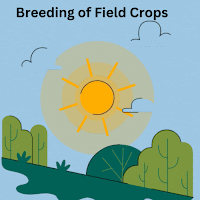
Organize Your Answers for Exams in Biology and Allied Subjects
Author: Prashant B Kale (Ph.D. Agril. Biotech)
Introduction:
Several exams in biology and allied disciplines at academic levels (graduate and PG exams) place a significant emphasis on strong answer-writing skills. Similarly, university entrance and recruitment exams commonly incorporate essay-type questions or long-written answers for better selection of candidates. Competitive exams, such as civil service, and medical also assess candidates' knowledge and analytical abilities through written components. Additionally, research-based exams and professional certification exams often demand well-structured and detailed written answers to evaluate candidates' understanding and application of the subject matter. Cultivating effective answer-writing skills is essential for success in these exams, as it enables candidates to express complex ideas, demonstrate critical thinking, and effectively communicate their knowledge and insights.
Table of contents: Introduction
Points to be considered
- Understand the question
- Plan your answer
- Utilize visual aids
- Introduction
- Main body
- Use subheadings (if appropriate)
- Critical analysis and discussion
- Conclusion
- References
- Proofread and edit
Summary
NoteWriting an organized answer in biology and allied disciplines requires careful planning and structuring of thoughts. Here's a ten-step guide to help when writing for an organized answer:
- Understand the question: Read the question carefully and make sure you fully understand what is being asked. Identify the key points or concepts that need to be addressed in your answer. (It is always better to meticulously go through the question paper before starting to write)
- Plan your answer: Before you start writing, create an outline or a mental framework for your answer. Determine the main points you want to discuss and the order in which you will present them. This will help you maintain a logical flow throughout your response. (This point should be consistently planned while making short notes in the classroom, preparing for exams/ studying during the semester period)
- Utilize visual aids: In biology, complex concepts can often be better understood with the help of visual aids. Consider incorporating drawings, figures, or flowcharts into your answer to illustrate key processes or structures. Use arrows, labels, and highlighting to emphasize important details. (One can practice understanding the concepts by preparing their own graphical abstracts during exams.
- About introduction: Begin your answer with a concise introduction that provides context and sets the tone for your response. Clearly state the main topic or issue you will be addressing and briefly outline the key points you will cover.
- Main body: Divide your answer into several paragraphs, each focusing on a specific point or subtopic. Start each paragraph with a clear topic sentence that introduces the main idea of that section. Support your arguments or statements with relevant evidence, such as scientific studies, experimental data, or reputable sources. Make sure to explain complex concepts or technical terms in a clear and concise manner.
- Use subheadings (if appropriate): If your answer covers multiple subtopics or aspects, consider using subheadings to help organize your thoughts and guide the reader. This can enhance the readability and clarity of your response, especially for longer and more complex answers. (Do remember the points like “classification”/ “types”/ “divisions” /”Approaches” / “methods” of the main title. Elaborate on those points scientifically. Be precise and consider the mark distribution to that particular question. Do not leave blank bullet points in the answers)
- Critical analysis and discussion: It is important to demonstrate critical thinking and engage in in-depth analysis. Evaluate the evidence you have presented and discuss its implications, limitations, or potential alternative interpretations. Compare different viewpoints or theories if applicable, and highlight the significance of your findings or arguments.
- Conclusion: Summarize the main points of your answer in a clear and concise manner. Restate your hypothesis or main argument and briefly recapitulate the conclusions. (Avoid introducing new information in the conclusion)
- References: If you have cited any sources, include a list of references at the end of your answer. Follow the appropriate citation style and ensure the accuracy and completeness of your references.
- Proofread and edit: After completing your answer, take the time to carefully proofread and edit your work. Check for grammar and spelling errors, ensure the clarity of your sentences, and make any necessary revisions to improve the overall structure and coherence of your response.
Summary:
Writing an organized answer in biology involves presenting your ideas in a clear, logical, and well-supported manner. Practice effective communication, coherence, and critical thinking to deliver a comprehensive and cohesive response.
NOTE:
Conceptual understanding is the key to better answers in biology. It enables in-depth and insightful responses by connecting information, recognizing patterns, and analyzing biological phenomena. A solid conceptual foundation allows for clearer explanations, logical organization, critical thinking, and informed conclusions. While factual knowledge is important, it is the application of concepts that matters. Build a strong foundation through active learning and exploration to excel in providing well-organized answers.



.gif)

















